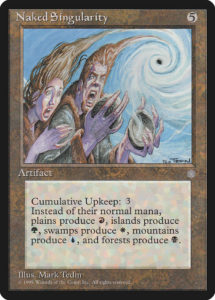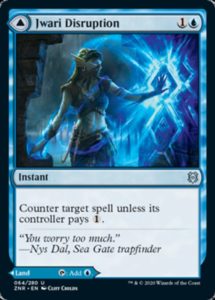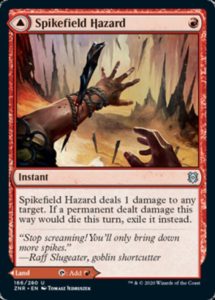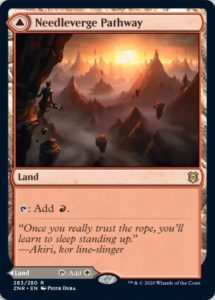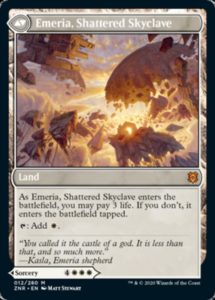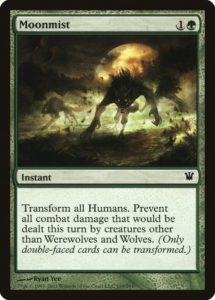Double-Faced Cards are a polarizing but mostly loved innovation from 2011’s Innistrad. Nine years later, Zendikar Rising introduces the second major innovation in DFCs: Modal DFCs (and renames the original kind of double-faced cards as Transforming DFCs). Rather than have a dedicated front face which can transform into the back face, they function similarly to split cards such as Fire // Ice, where you have a choice of two effects. Unlike split cards, Modal DFCs are allowed to have a permanent on either or both faces.
Today, we’re going to talk about the execution of MDFCs (get ready to see that acronym a lot) in Zendikar Rising. But before we get to that, there was a quiet but dramatic announcement.
The Block Hole
Five years ago, the age of old blocks ended with Dragons of Tarkir. In most years from 1995-2015, Magic visited a single world (or part of Dominaria). The first set generated the most excitement, since both the worldbuilding and its mechanics were fresh. The second set was less novel, since it featured the same location, most of the same mechanics. The third set struggled the most, since it had the least novelty and had to balance innovation with continuity to the rest of the block. Magic solved the third set problem by eliminating the third set (and Core Sets) and visiting two worlds a year, generating more excitement with more novelty. By 2018, second sets would also be eliminated. But there was a tradeoff to this approach—without blocks, sets mechanics didn’t overlap. Themes could overlap, like monocolor in Throne of Eldraine and Theros Beyond Death, but Adventures, Food, and Mutate were marquee mechanics locked into single sets. There was no way to innovation on these mechanics or spread cards across multiple sets, since everything had to fit into a single set.
The sets of 2020-2021 are going to try and fix this problem with Modal DFCs. The next three expansions will all use MDFCs in different ways despite taking places on three different worlds. This means the mechanic can develop over time, that decks based around it can gain cards over the entire year, and that we’ll perhaps see more linear decks relying heavily on multiple sets. This is an exciting experiment into putting more glue between sets. Yes, this runs the risk of regaining an old problems of the block model (diminished novelty and therefore consumer enthusiasm); but with the worlds being completely different (and their other mechanics presumably not overlapping), this issue should be alleviated.
I’m curious about what other mechanics can play this role if the experiment is successful, since they need to have deep design space, have multiple expressions, and be thematically broad enough to fit on multiple worlds. We last saw such an experiment with Morph, Manifest, and the ill-fated Megamorph—perhaps Morph might once again be the complicated glue to an entire year.
Familiar, but Different
Every MDFC in Zendikar Rising works the same way: the backside is a land. Excepting the six rare dual lands and the five mythic rares, all MDFCs have a spell on their front side and their backside is a land that taps for a single color and enters the battlefield tapped.
Jwari Disruption seems like one of the more fascinating cards to delve into, so let’s start with it. It has a clear ancestor in Force Spike (which we discussed last week); but most resembles Censor, a card just introduced to Historic thanks to Amonkhet Remastered. Censor is a player in Pioneer and Historic as an effective (and frustrating) counterspell early in the game, while it cheaply cycles away as soon as it ceases to be relevant or you need to hit a land drop. Jwari Disruption is a relevant counterspell in the early game and guarantees you the early game land drop Censor might look for, but offers none of the long-game benefits that Censor does.
While other MDFCs can generate a relevant Landfall trigger, blue tempo-control decks are unlikely to derive much benefit from that. At first glance, Jwari Disruption seems just worse than Censor, since it’s slightly better in the early game and substantially worse at subsequent points. But that’s because we’ve skipped over the part of the game where Jwari Disruption and all other MDFCs truly shine: deck construction.
When you put Jwari Disruption in your deck, it will almost certainly replace an island rather than a spell. Censor, on the other hand, takes up a spell slot. While you can Cycle Censor in the late game to find an Absorb or Teferi, Hero of Dominaria, its inclusion in the deck takes up a space that could’ve instead been the card you wanted. Censor reduces your deck’s threat density, making it so you have fewer relevant spells in the late game. Jwari Disruption increases your deck’s threat density, since it upgrades a land slot into a sometimes-relevant spell, while in the late game it’s exactly as useless as the island it replaced. While there is a real cost to playing enters-the-battlefield tapped lands, the power of land slots providing relevant spell effects cannot be overstated. I cannot wait to try this card out for myself.
Geist Maim
One of the harder MDFCs to evaluate is Spikefield Hazard. While the spell-sides of most MDFCs tend to have already-playable effects or context-sensitive effects (that tend to cost one mana extra due to the benefits of being a MDFC), Spikefield Hazard is the kind of spell that no deck would willingly include on its own. Even Gut Shot requires a specific metagame or hyper-focused deck to function—and it’s free. One damage just isn’t enough to justify inclusion.
One could argue that monored aggro decks would be happy to have a land that can turn into burn, especially since Ramunap Ruins was so good it got banned in Standard. However, monored decks have to spend their mana efficiently. Spikefield Cave simply can’t do. The opportunity cost of playing this in Constructed is likely too high to justify. But in Limited, games go longer, it’s easier to find a spot to sneak in an ETB tapped land, and there are a lot of one toughness creatures in ZNR.
Spikefield Hazard probably couldn’t deal any amount of damage other than 1. Shock is a relevant spell in most situations, so it’d feel incorrect to ever play Spikefield Cave, unless Spikefield Hazard were ludicrously overcosted, such as a five cost, sorcery speed Shock. The weakness of the spell is an example of smart game design, since it encourages players to play the land half when they need it rather than hinder their mana development for fear of missing out on a good removal spell.
Crossing the Line, and it’s probably fine
There are six Pathways (the remaining four will be in Kaldheim), and they push a boundary nonbasic lands have been constrained by since the Alpha dual lands were deemed too good—they enter the battlefield untapped, give you a free choice between two colors, and have no downside. Nonbasic lands were always held to the standard of not being strictly better than basic lands, but in isolation these are. This line was toed by the Throne of Eldraine castles, since they had massive advantage and a minimal cost, but they did have a cost and they still didn’t break Magic.
There are two questions about Pathways. First, just how much of a disadvantage is it to lack basic land types? Basic land types have become more commonplace in recent years so that cards like Savai Triome, Irrigated Farmland, and Cinder Barrens can work alongside cards like Castle Locthwain, Port Town, and Rootbound Crag. There is some cost playing a Clearwater Pathway if you need Glacial Fortress to be untapped or are afraid of Blood Moon, but there’s a second and bigger question: are the pathways better than that which came before?
The Pathways seem likely to have similar play patterns to the Zendikar fetchlands. These only could fetch basic lands in Standard, so they gave you the same binary and permanent choice between one of two colors. The fetchlands were likely stronger, since the one life loss likely paled in comparison to the benefits of double landfall triggers for Steppe Lynx or shuffling after Jace, the Mind Sculptor Brainstormed.
From a practical perspective, the Pathways might not be a sea change in card design. Yes, they do cross a line, but sometimes lines drawn in the sand lose their meaning and cease to be helpful. One could levy the charge that the Pathways are mandatory inclusions in multicolor decks and are cash grabs, but let’s be honest: there are always a finite amount of rare dual lands in Standard and they all demand inclusion due to the importance of good mana. Let’s see how they play out.
Big Power, Small Cost
Zendikar Rising introduces the first ever cycle of mythic rare lands. We’ve seen individual lands at mythic (like Eye of Ugin and Mirrorpool) and the Expedition cycles of Battle for Zendikar block, but this is the first time Standard will have a cycle of mythic lands.
And, well, these are quite powerful. They’re more akin to the Eldraine Castles than the Zendikar Rising Pathways, since they have a clear cost and can’t simply go in any deck. That said, having a split card between an untapped (if you really need it) land and a powerful endgame spell is an exciting and powerful option. Emeria’s Call could be an expensive, maindeck control finisher that sits in a land slot (hearkening back to the first days of Transforming DFCs when Innistrad control decks won with Nephalia Drownyard), but it stands apart from the bunch.
Sea Gate Restoration seems more niche, since it’s a sorcery, is pretty limited in how many cards it can draw (once you’re casting seven drops, you tend not to have many cards in hand), and is a lot of mana to spend on something that doesn’t affect the board. But again, the cost of including this in a deck that wants this effect is nearly negligible. Turntimber Symbiosis seems like a fair way to give heavy green decks some extra oomph in the late game or reward the green ramp decks that have seen several bans this year.
Then there’s Shatterskull Smashing—a super powerful Limited spell but a horribly inefficient removal spell in Constructed. I’d comment on the black member of the cycle, but it hasn’t been spoiled at time of writing, so all I can say is I’d wager it doesn’t cost 4BBB (if it did, it’d be a cycle where four cards have the same cost structure but the fifth breaks the trend, an aesthetic violation that tends to need a strong justification).
What’s most interesting to me about this cycle is how differently they’ll function in Limited and Constructed. In Constructed, these will take land slots in decks—you’ve got plenty of powerful things to do and it won’t hurt your game plan to play these as lands. In Limited, these probably belong in spell slots, since Shatterskull Smashing and Emeria’s Call are spells you’ll always want to cast unless you’re in desperate need of lands (or have the ability to bounce the lands). While most MDFCs are fairly restrained in their spell effects so as to maintain an interesting choice about which half to play, that paradigm breaks down for this cycle but only in Limited.
That’ll do it for today. Here’s looking forward to seeing the last of spoilers this week, studying the Limited format for next week, watching the Mythic Invitational, and playing in the Qualifier Weekend. It’s a busy week and we haven’t even gotten to the best part—playing with the new set. Until then, and as always, thanks for reading.
—Zachary Barash is a New York City-based game designer and the commissioner of Team Draft League. He designs for Kingdom Death: Monster, has a Game Design MFA from the NYU Game Center, and does freelance gatame design. When the stars align, he streams Magic (but the stars align way less often than he’d like).

